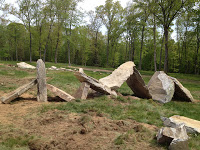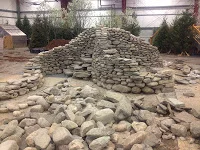The use of an old millstone as a lawn ornament is a notion that never grows old. They’re seen laid flat with flowers growing from the central axle hole, or set on edge with the lower portion buried in the ground. The mill building, where the stone once turned, may be long gone but the stone endures and remains a symbol of industry and ingenuity from times past.
Read MoreWorking with “free stone” offers freedom from and freedom to. The basic rules of dry stone walling, as outlined by the DSWA, are simple and effective. When they’re applied, at home, for a client, in a workshop or during certification testing, no second-guessing is required. The path forward is clear if not always straight. To a large degree, the rules create freedom from uncertainty.
Read MoreWho pays good money to do hard labor on their weekend off? Are they a bunch of nuts? No, they’re two dozen good eggs who joined in on The Stone Trust’s dry stone walling workshop. Lead by DSWA instructors Andrew Pighills, Brian Post and me, they studiously applied the rules they learned for wall building and restored a long stretch of fence (originally constructed one hundred years ago by ten Italian masons) to its former glory. Thanks to all for a great weekend of walling.
Read MoreThe stone globe I built in 1983 had become timeworn. The hollow construction cracked open under the strain of carrying its own heft for thirty years. Barbara and Ernie commissioned the original. Their daughter, Nicole, asked me to bring it back to its former glory. In the intervening years I’ve laid up hundreds of dry stone constructions. I like to think I’ve learned a new thing or two along the way. The process of rebuilding the ball taught me that I both have, and haven’t.
Read MoreWhile I was in Newfoundland, ET, John, Andy, and the rest of the crew were making a full size mockup of the three-stone piece that will soon be installed on Hogpen Hill. The “inflatable stones,” as ET refers to them, are made from steel frames sheathed in plastic shrink-wrap. Yesterday the mockup took flight, with the aid of the excavator bucket, around the field seeking a site for the permanent installation.
Read MoreReflecting on the recently completed 2-day workshop at English Harbour Art Centre, I begin to see that perhaps the most useful function I perform as a walling instructor is offering permission to those in attendance to try something new. For a participant, the workshop setting is a green light at an intersection that otherwise would be blinking red. Because the building site has been prepared with footings dug, guidelines strung and stones laid out on the ground, around, the usual impediments to getting started building a wall have been removed. A participant feels free to act and is encouraged to begin.
Read MoreWhile the Northeast of the USA was sweltering, the weather in the Jotunheimen mountains of Norway was bracing. Cold winds and cloudy skies for the Turtagtrø dry stone walling workshop had me and the participants glad for some vigorous physical activity to stay warm. Of course, for the Norwegians it qualified as mild weather. As Morten gleefully pointed out, “If it’s not snowing, it must be summer!”
Read MoreDue to a number of structural problems, an eight-year-old, dry stone retaining wall in Hanover, New Hampshire was dangerously close to collapsing. I was asked by the property owner to remedy the situation. The rebuilding of a 6’x30’ section of retaining wall is often a straightforward business. But because this wall was in a well established, backyard garden with poor access and little room to store materials at the site, the build was a logistical puzzle. Concern was added to those challenges when, as work commenced, a municipal sewer line was discovered to be located scarily close to the back of the wall.
Read MoreHere’s a little secret about building a dry stone wall on a busy construction site: work on the holiday. I spent the Memorial Day weekend constructing a seating wall for the Hall Art Foundation in Reading, Vermont. While packs of touring motorcyclists occasionally rumbled past on Route 106, bird song was the predominant sound track. No distractions from the other contractors, who are busy there on the weekdays, meant I could concentrate on the task at hand. I built two sections of wall beside one of the galleries at Vermont’s newest art museum.
Read MoreThe difference between stone and rock is that rock only becomes stone when it gains employment. Whether fixed or loose, rock belongs to the earth. When humans pick it up and turn it to a use it becomes stone. There are many ways to make the transformation. Here are two examples.
Read MoreOver the past few months I’ve been a guest speaker and adviser to senior students in the architecture department. Their thesis project was to develop a program, and design the buildings and grounds for The Water House, a destination spa and environmental education center being built in western Massachusetts. The studio was sponsored by the New England distributor of Marvin windows, A.W. Hastings. Prizes were offered to the top three designs, judged by me and and a dozen other landscape professionals and regional architects.
Read MoreAfter the tragic events to our south in Boston at the start of last week it was heartening to end it on Saturday with a positive note. Nine candidates came to The Stone Trust facility at Scott Farm for DSWA craftsman certification tests. After seven hours of intense walling activity, passing marks were awarded to Level 1 and 3 participants by the DSWA examiners; myself and Chris Tanguay. Candidates came from Massachusetts, New Hampshire, New York, Pennsylvania and Newfoundland, Canada to test their dry stone construction skills against what are recognized to be among the most rigorous standards found anywhere in the world. Congratulations to all!
Read MoreDriving on the left side of the road, rubber sink-stoppers on a chain, grilled tomatoes for breakfast; these are some of the things to get used to, quickly, when on a six-day visit to the UK. I was there to take part in the DSWA Standardization and Assessment weekend for craftsman scheme examiners. Along the way, E. and I took in two of the three legs of the “Yorkshire Sculpture Triangle.”
Read MoreWhile the Standardization can be a bit stressful and nerve wracking at times, I look forward to reuniting with a great group of professional wallers.
Read MoreCollecting sap from buckets hung on the maple trees in our sugarbush begins the process of turning clear liquid into amber syrup. Boiling down the sap is done in a set of stainless steel pans on an “arch” in the sugar house. The firebox, stoked with limb wood and lumber mill scraps, provides the heat.
Read MoreTwo days worth of indoor stone slinging last week completed the central stone feature at the Vermont Flower Show. Jared, T.J., Jamie, Brian and I finished up “Craggy Mountain” just as the trees, mulch and flowers closed in around us. On Friday I offered my slide-talk, “Working Stone,” to a standing-room-only crowd. The following words were part of the presentation’s introduction.
Read MoreThe past two days have been a swirl of activity as months of planning finally came together, including the 25-ton dry stone installation created by Jared Flynn, Jamie Masefield, T.J. Mora, Brian Post and me. Behind the scenes, Charley McMartin coordinated the collection and delivery of the stone and will take care of the break-down Sunday night.
Read MoreThe age-old skill of constructing in dry stone is still alive today and being practiced by a growing number of professional wallers. Two weeks from now, a team of DSWA certified craftsmen from around the region will meet at the Champlain Valley Fairgrounds in Essex Junction, to create a unique feature (scale model in photo) for the upcoming Vermont Flower Show.
Read More
















